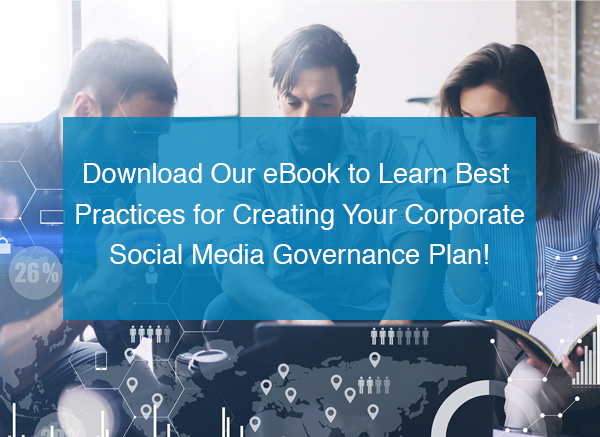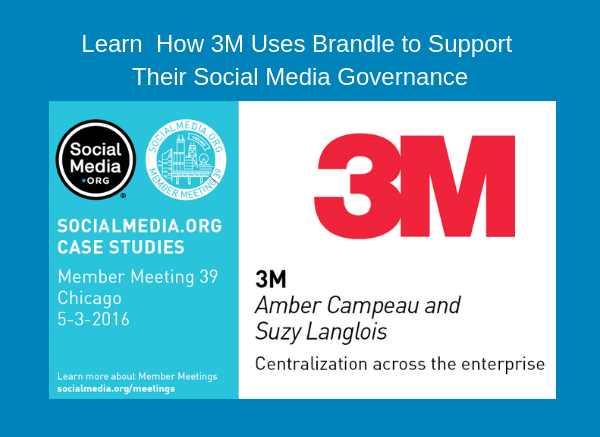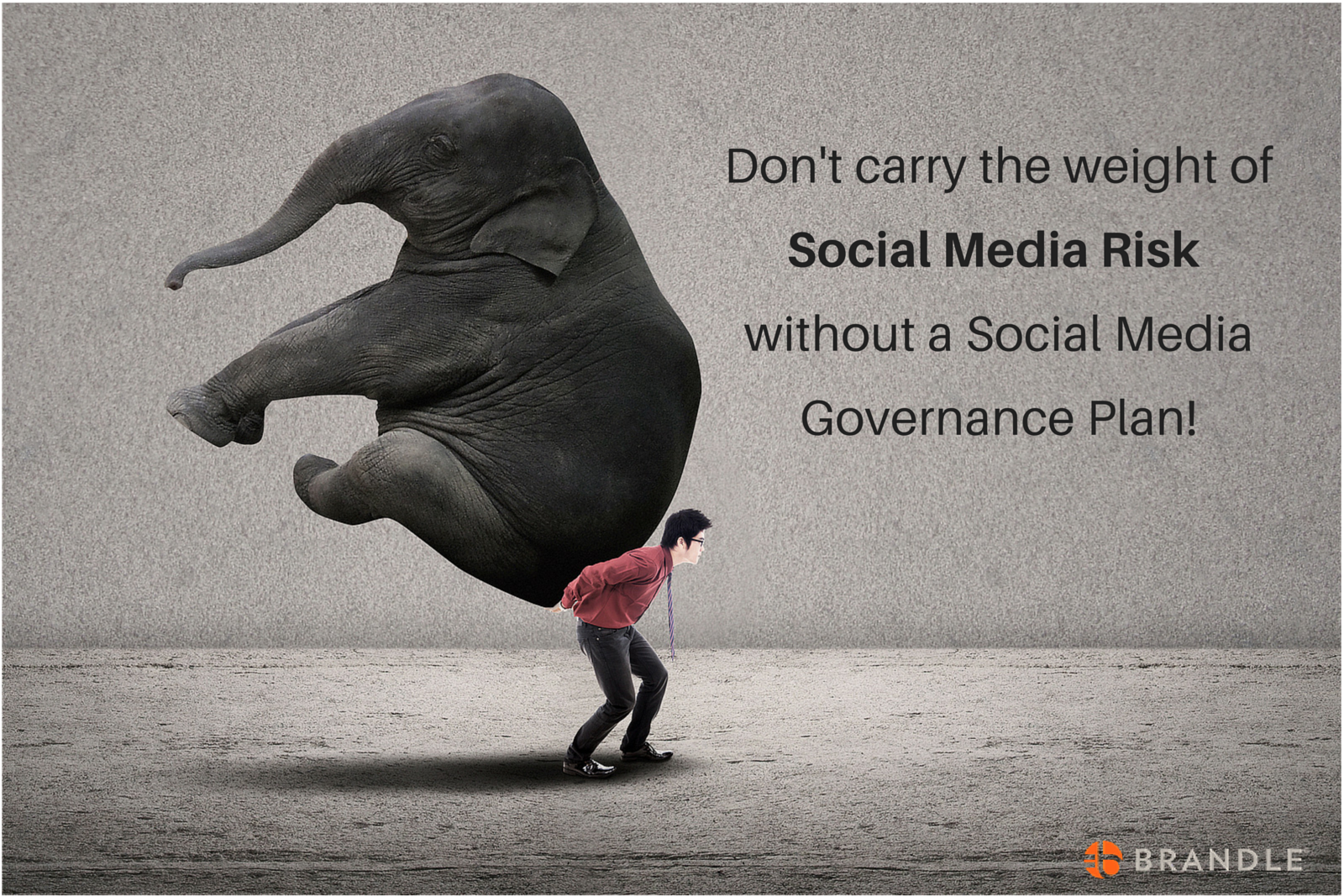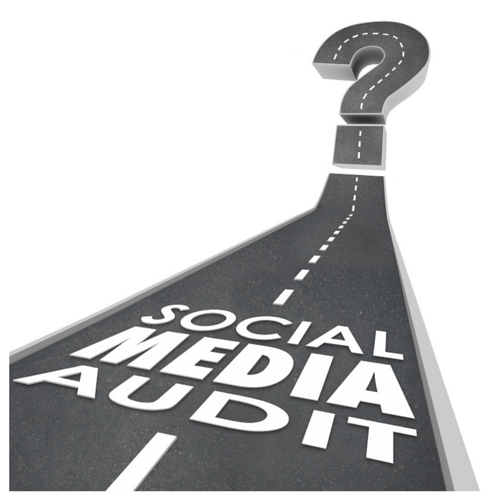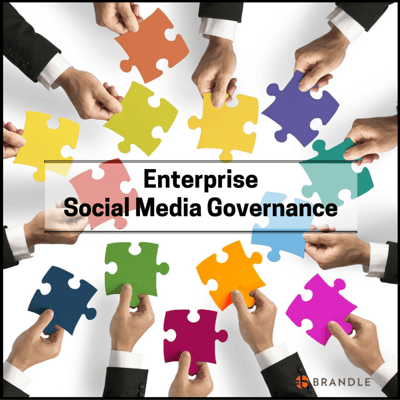 Social media governance is an ongoing process with the primary goal of mitigating risks for your company. Research shows that corporations consider reputation damage as the most crucial risk concern with technology threats in the top ten. Social media risks fall under both of these risk concerns.
Social media governance is an ongoing process with the primary goal of mitigating risks for your company. Research shows that corporations consider reputation damage as the most crucial risk concern with technology threats in the top ten. Social media risks fall under both of these risk concerns.
To be successful at managing social media risks, it is critical to have a Social Media Governance Plan in place and to work the plan. It is also critical to ensure the plan ties into the overall corporate risk management program.
Whether you are creating your first Social Media Governance Plan or updating your current one, you need to make sure you cover all of the elements that are important to your company.
In Part 1 of this blog series, we focused on the first steps to prepare for your plan creation:
1. Gather the Corporate Stakeholders of Social Media Governance, and
2. Review Corporate Risk Management Priorities
This post (Part 2) continues with the items you need to consider for your Social Media Governance Plan.Your Social Media Governance Plan, Steps 3-6
At this point in plan development, you have reviewed the key corporate risks and priorities and you've targeted the key corporate stakeholders who will help manage and uphold the Plan. Now it's time to jump into more specifics on the corporate goals and social media risks for the company. Note — every company has specific needs, so you may want to alter this suggested outline and process to ensure your plan is most effective for your company.
The remaining steps to create your Plan are:
3. Review the Corporate Goals for Social Media Governance
4. Analyze Previous Successes, Failures, and Changes
5. Social Media, Employment, and Industry Law and Regulation Review
6. Review Corporate Social Media Policy
7. Social Network/Platform Review
8. Social Media Audit Process — Discovery
9. Social Media Governance Process
10. Procedures when Risk Event Occurs
11. Train Employees on Social Media Governance
12. Monitoring Procedures to Ensure Governance
13. Review Cycle for Governance Plan
Corporate Goals for Social Media Governance
We know that you have already started implementing your 2016 goals for social media marketing and relationship building, but what about general business goals for social media?
Perhaps 2016 is the year you want to greatly expand social media within your company to allow many more employees to advocate for your brand(s). This would be a corporate social business goal and it certainly could open up the corporation to greater risk. So this particular goal would need careful consideration about governance, such as a roll-out program, changes in policy, training, and monitoring to manage the risks associated with expanding your corporate social footprint via employees.
We are also seeing more companies spearhead governance to gain a focused and controlled web presence practice. Now that there are GRC tools and social media monitoring tools available for governance, such as Brandle, global companies understand that they can have better control over their web presence (including social media) as well as oversight of other organizations and people who are associating themselves with a brand. All of these online points of presence are customer touch points that add, or subtract, from brand reputation. Perhaps this is the year that control of your digital brand presence is a key corporate business goal for social media governance.
Are there other corporate goals that might play out on social media and need additional governance consideration?
Remember, governance is primarily about protecting your brand as a risk management practice.
Secondarily, governance is about strengthening your brand, such as ensuring brand standards and voice are consistent across platforms, which strengthens brand reputation.
So a goal of reviewing all social media profile descriptions for brand consistency and voice might be a good governance goal as well, especially if you have a distributed global social media marketing practice.
Example Social Media Governance Goals
Here are some areas to consider for goals and governance in 2016.
- Analyzing corporate-owned social media site protocol. What is the protocol to set-up a new account, secure credentials, confirm strategy, apply tags for reporting, take down an account, define KPIs and reporting schedule, etc. What is the global protocol for this?
- Creating a stronger management process for the different social networks. For example, determining which business units need to be included under the Facebook Business Account Manager and if this is the time to implement a Global Pages strategy?
- Incorporate platform-generated place pages and user generated pages (such as Facebook generated Wiki pages) into governance process. If you are a retail business, then this is truly an important goal. How will you monitor or manage these? Will you merge all of the platform-generated place pages with the company-generated business pages?
- Conduct a social media security and tech vulnerability analysis on your social media presence. What apps are connected to your accounts? What SaaS tools? Where are the credentials for central management? How secure are your accounts and is there risk to the company if the account is hacked? If you are conducting social selling, this is an even greater risk threat.
- Conducting a complete website and social media audit for brand protection, with a strategy of taking down all dormant sites and reviewing infringing and counterfeit sites with your legal team for Cease & Desist notices.
- What are the goals you may have with third-party sites? Employee-owned sites (especially in regulated industries), community-generated sites, partner-generated sites associating with your brand?
- What are your team and employee training goals — e.g. core team development, employee ambassador training, etc?
- Is the business expanding in other countries? How will social media be managed and governed in those countries.
- Agency Management: If you have external agencies supporting efforts, what are the Governance Goals for them? They aren't part of your corporate stakeholder team, but depending on the services they provide for you, they may very well be on the front line to risks. In-depth training on the governance plan and protocols is essential.
- If you are in a regulated business, you may have a goal of a higher percentage of employee compliance on social networks. You may also have an internal goal of creating a deeper pre-approved content library for employees, ensuring compliance.
Do any of these areas need particular focus for your governance plan? Define the social media governance goal and develop the approach to how you will achieve the goal. The approach can be outlined in the Social Media Governance Process area of the Plan.
Previous Successes, Failures, Changes in your Social Media Governance Practice
Recognizing the successes and short-comings of a previous year is a great way to ensure you don't make the same mistakes. It's also a good way to brainstorm how to strengthen governance goals. Review your successes, failures, and disappointments (or unmet goals) and make sure you update your goals and procedures with improvements.
Some Social Media Governance Successes and Failures may include:
- Lost/compromised passwords, leading to lengthy procedures with a social network.
- Ad hoc tool chain/set managing accounts, that caused governance issues.
- Poor, inconsistent branding across accounts.
- Inappropriate messaging.
- Messaging at cross purposes (lack of coordination).
- M&A (merger, acquisition, or divested business unit ) headaches around social accounts.
- Successful new acquisition or successful global launch of a new product or brand, and how social media risks and governance were considered before activation.
- Missed opportunities/ surprise opportunities captured.
- Long response time on a crisis, making crisis escalate.
- Consider highlighting successful KPIs, such as listing the number of pages/accounts you managed to "close" due to abandonment or the number of secured accounts with all corporate brand names across new social platforms.
- Did not meet goal of rolling out advocacy program. If the plan is good and timing is right for 2016, you may want to incorporate unmet goals from last year into your 2016 Goals.
You get the idea.... Again, review and then develop the approach to how you will address the failures, reinvigorate the goals that were not realized, and repeat the successes (or apply similar protocol to other areas to achieve new successes).
Social Media Law and Regulation Review
State laws, national laws, and industry regulations (per country) are constantly changing. Be sure your team is clear on all legal aspects of social media (and general advertising and labor laws around all digital communication). Your governance certainly needs to follow, and support, all laws and regulations.
For many laws and regulations, the specific guidelines (such as United States' FFIEC, CFPB, FTC guidelines), not only address what can be stated in social communication, but what must be included (such as a mortgage lenders NMLS # and corporate affiliation) in the profile description so it is quickly recognizable by a consumer. Make sure you understand everything expected in Laws and Regulations. Some examples include:
- A Requirement that all social media content must be archived.
- A pre-approved content library is required for employee use.
- Historical record-keeping of procedures required and readily available in case of audit.
- Remediation Policy and Procedures formally documented and published.
- Does your Social Media Policy prevent employees from making a negative comment about the company on their personal website? Do you require access to an employees accounts? Those are both NLRB violations.
- If employees are stating anything to mislead a consumer on social media, then you most likely have a problem.
Understand and make a list of all Laws and Regulations; then document where you need to apply them in the Social Media Governance Plan. They absolutely need to apply to your Social Media Policy, and the key risk factors that arise from social media.
Social Media Policy (or Policies)
Your corporate social media policy is certainly part of your governance plan and should be reviewed every year with your social media governance team to ensure that it is still up to date.
The key elements to include in your general Corporate Social Media Policy:
- Is it legal per your State and NLRB laws? Other country laws? Several new laws were passed last year, so review these with your legal counsel.
- Does it protect/support the company from the major risks concerns?
- Does it support your social media goals, marketing goals, corporate business goals and your corporate culture?
Also, it is a good idea to have additional policies for those employees (and vendors) who are approved to work on corporate social media or use their personal accounts to conduct business on social media.
Consider different functional social media policies for:
- All employees, delivered as part of the employee handbook.
- Social media management employees. These are the people responsible for the corporate social media accounts, content, posting, analytics, governance, etc.
- Sales and/or customer service team. These are people that are responsible for communicating directly with customers via corporate-owned channels or their own accounts.
- Agency. You may have an outside vendor supporting your effort. There should be clear policy elements (such as ownership, limited access to credentials, etc.) and these should be attached to the service contract, if not directly included.
Ensure your legal counsel reviews the policies. Create the policy dissemination protocol and determine whether specific training is needed to communicate the policies effectively. Employee training is a key topic in later in this series.
Next week, we will continue this series on social media risk management and governance. At this point, you are well on your way to creating a thoughtful Social Media Governance Plan that will be a powerful tool for solid enterprise web presence management.
If you'd like to know more about Brandle and how we help you with Social Media Governance, just drop us a line.



